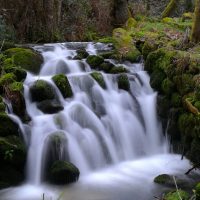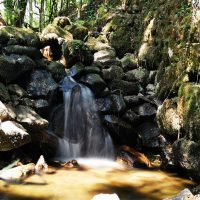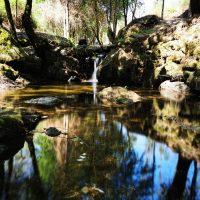Sobre o local
O Trilho dos Moinhos do Pontido inicia-se com uma subida muito suave até vislumbrar, na margem esquerda da linha de água, o primeiro dos nove moinhos, em ruínas, que constituem este riquíssimo património molinológico do ribeiro do Pontido. Aqui o silêncio impera, se o visitante fechar os olhos consegue ouvir a água a correr nas labirínticas levadas e idealizar o ruído estridente das mós a moer o grão para produzir a farinha que dava o sustento aos nossos antepassados.
Depois de uma verdadeira viagem no tempo e atravessar uma floresta frondosa e encantadora, o percurso interseta a via romana XVII que nos levará ao Castelo de Lanhoso ou ao Carvalho de Calvos.
Para o Castelo de Lanhoso deve-se virar à esquerda na via romana XVII, outrora importante eixo viário que ligava Bracara Augusta (Braga) a Asturica Augusta (Astorga, Espanha) e que atualmente integra a Grande Rota 117 (GR117), no caminho de terra batida até atravessar o ribeiro do Pontido, sobre uma ponte formada por blocos graníticos. Umas dezenas de metros mais à frente, debaixo de um esplendoroso carvalhal, inicia-se uma subida até à estrada em asfalto. Depois de a atravessar, volta-se a subir ligeiramente até alcançar-se o sopé do Castelo de Lanhoso. A partir daqui, inicia-se uma ascensão desafiante que nos transporta para um imaginário de cercos e batalhas históricas, aqui vividas, determinantes para a defesa e ampliação do Condado Portucalense, sendo também um dos monumentos que melhor evoca a memória de D. Teresa, mãe de D. Afonso Henriques, primeiro rei de Portugal.
Download do Percurso: KMZ | GPX
Para o Carvalho de Calvos deve-se virar à direita na via romana XVII, no caminho de terra batida que serpenteia a meia encosta do monte, até dar início a uma suave subida que termina no imponente e luxuriante Carvalho de Calvos, considerado o mais antigo da Península Ibérica e o segundo mais velho da Europa, sendo necessário, aproximadamente, 10 homens adultos para o abraçar. O parque, com uma área de 3.1ha, é o local perfeito para atividades físicas de ar livre, piqueniques, mas também de aprendizagem.
Download do Percurso: KMZ | GPX
🇬🇧 TRAIL DESCRIPTION 🇬🇧
To iniciate the Moinhos do Pontido trail, you must follow the dirt track that runs along the left bank of the stream to the north end of the park.
After crossing the asphalt road, the trail starts with a smooth climbing until you can see, on the left side of the water stream, the remains of the first of nine Water Mills, an interesting heritage of ribeiro do Pontido. You will find a reign of silence there, if you close your eyes you can appreciate the sound of the waters running through a maze, defying you to imagine the shrill noise of the millstone grinding the grain to produce the flour that provided sustenance for our ancestors.
After a true time traveling and crossing the lovely and charming forest, the trail intersects the roman road XVII that will lead you to Castelo de Lanhoso (Lanhoso Castle) or Carvalho de Calvos (Calvos Oak), depending on the direction you may take.
If you are going to Castelo de Lanhoso (Lanhoso Castle) you should take the left path - this was once an important path connecting Bracara Augusta (Braga) to Asturica Augusta (Astorga, Spain) which integrates today the Great Route Trail 117 (GR117) - in an unpaved path until you cross the ribeiro do Pontido (Pontido’s Brook), over a small stone bridge.
A couple of dozen meters ahead, under a splendorous oak grove, starts a climbing path until you reach an asphalt road. After you cross the road, you should continue up until you reach the foot of Castelo De Lanhoso (Lanhoso Castle). And here starts a challenging climbing path that will take you on an imaginary trip, where sieges and historical battles that happened in that same soil and became determinant for the defense and expansion of the Condado Portucalense (Portucalense County), being also one of the monuments that best evokes the memory of D. Teresa, mother of D. Afonso Henriques, the first king of Portugal.
To the Carvalho de Calvos (Calvos Oak) path, turn right on the roman route XVII, on the dirt track, until you start a soft climbing that will end in the imposing and luxurious Carvalho de Calvos, considered the oldest and the largest of the Iberian Peninsula and the second oldest in Europe, requiring approximately 10 adult men to hug this Oak. The park, with an area of 3.1a, is the perfect place for outdoor physical activities, picnics, but also for learning.




